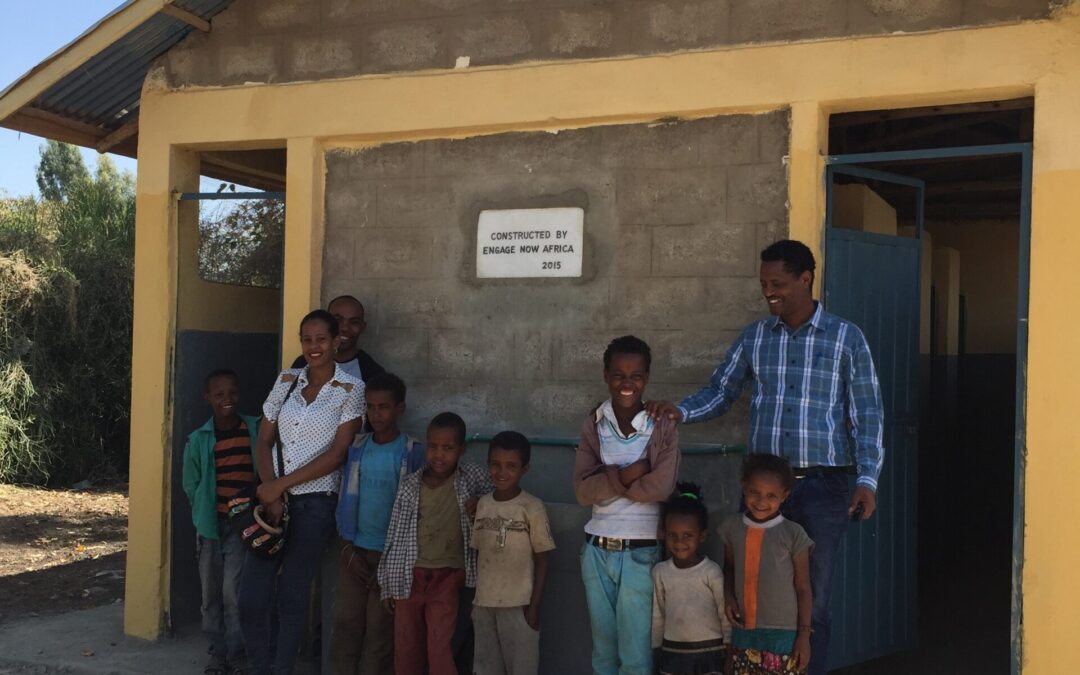The person must be willing to help dig the pit. If he can afford it, he/she may hire someone will help with the digging.
The family determines what they can contribute financially to the building of the latrine. If they cannot afford anything, we help with the digging, and provide eucalyptus wood and rocks for the base, as well as, a bamboo privacy enclosure to the latrine.
ENA will also provide a gerry jug, hygiene training, soap and demonstrations on how to properly clean and sanitize the facilities.
The picture below is of one recipient who was able to purchase sheet metal to go around his latrine, which will provide more privacy and protection from the elements than the traditional bamboo.
![IMG_1481[1]](http://ibt.348.myftpupload.com/wp-content/uploads/2016/08/IMG_14811-e1472437123885.jpg)
Latrines are dug deep into the ground and then reinforced with rock so the latrine is structurally sound and does not cave in. Deep latrines will last 25 plus years! Those who cannot dig them this deep are able to dig a shallower hole that is reinforced with stone, but will need to be replaced in 5-10 years.


![IMG_1538[1]](data:image/gif;base64,R0lGODlhAQABAAAAACH5BAEKAAEALAAAAAABAAEAAAICTAEAOw==)
We are also in the process of building our second community latrine at a community market site. On market days there are 2,000 to 5,000 people in attendance and there are also two smaller market days during the week with at least 1,000 vistors. In the past, there was nowhere for people to go to the bathroom, so they would defecate openly in surrounding fields. The community/public latrine is made out of brick and mortar with sheet metal roofing. There are 6 stalls (3 for women, 3 for men) with two washing stations at the site.
Pictured below are the Community Latrines under construction.


Although the widespread health effects of these latrines are difficult to measure, we know that they are saving lives and teaching thousands of people the importance of hygiene and sanitation every week at market.]]>
![IMG_1481[1]](http://ibt.348.myftpupload.com/wp-content/uploads/2016/08/IMG_14811-e1472437123885.jpg) Latrines are dug deep into the ground and then reinforced with rock so the latrine is structurally sound and does not cave in. Deep latrines will last 25 plus years! Those who cannot dig them this deep are able to dig a shallower hole that is reinforced with stone, but will need to be replaced in 5-10 years.
Latrines are dug deep into the ground and then reinforced with rock so the latrine is structurally sound and does not cave in. Deep latrines will last 25 plus years! Those who cannot dig them this deep are able to dig a shallower hole that is reinforced with stone, but will need to be replaced in 5-10 years.

![IMG_1538[1]](http://ibt.348.myftpupload.com/wp-content/uploads/2016/08/IMG_15381.jpg) We are also in the process of building our second community latrine at a community market site. On market days there are 2,000 to 5,000 people in attendance and there are also two smaller market days during the week with at least 1,000 vistors. In the past, there was nowhere for people to go to the bathroom, so they would defecate openly in surrounding fields. The community/public latrine is made out of brick and mortar with sheet metal roofing. There are 6 stalls (3 for women, 3 for men) with two washing stations at the site.
Pictured below are the Community Latrines under construction.
We are also in the process of building our second community latrine at a community market site. On market days there are 2,000 to 5,000 people in attendance and there are also two smaller market days during the week with at least 1,000 vistors. In the past, there was nowhere for people to go to the bathroom, so they would defecate openly in surrounding fields. The community/public latrine is made out of brick and mortar with sheet metal roofing. There are 6 stalls (3 for women, 3 for men) with two washing stations at the site.
Pictured below are the Community Latrines under construction.
 Although the widespread health effects of these latrines are difficult to measure, we know that they are saving lives and teaching thousands of people the importance of hygiene and sanitation every week at market.]]>
Although the widespread health effects of these latrines are difficult to measure, we know that they are saving lives and teaching thousands of people the importance of hygiene and sanitation every week at market.]]>

